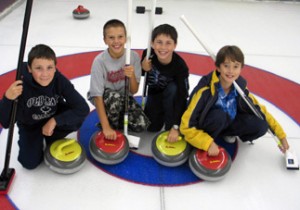Pebbles to Boulders: Special Needs Curlers
Curling, like many sports in recent decades, has come to adapt itself for the inclusion of persons with special needs. The main obstacle to overcome in many of these cases is understanding. By taking a step back to see how others play our sport in a non-traditional way, we all can learn so much about the human spirit.
Now I’ll be the first to admit that I have no long-term experience in working with curlers of special needs, but for a few examples that have touched me during my career.
I really think my first contact with a curler who had to be adaptive to play, was Sam Srigley. Sam was an educator in North York and a friend of my buddy Keith Reilly. I was in my early twenties, still pretty much wet behind the ears. One April, Keith invited me to play in the Fisherman’s Spiel in Timmins. Along with John Gerrie and Sam, we flew up to Timmins, where I had never curled at 2:00 am before; never seen tables filled with empty beer bottles with people still seated at the tables, before; never had an eye-opener before. Culture shock or what! Anyways, Sam delivered the stone left-handed because he had no right hand; lost in an industrial accident. What was amazing that these were the days of Rink Rat brooms (no brushes then)! Sam played lead, throwing two and sweeping six each end, and I tell you, Sam could swing and pound this broom like no one I’d seen before! The noise, for those who can remember; Sam made the rafters shake. I was in awe. We won the spiel. First prize were Scott 16 foot canoes; my first canoe.
My next exposure to adaptive curling, were those who were deaf. Sure these folks could throw and sweep in the traditional way, but the communications were all with special signals and sign language. It became very interesting to see how teams tried to disguise their internal discussions from the opponents. Turning ones back from you was not considered an insult, but just part of the game, so the team could keep their game plan to themselves. As you can imagine, this group was very aware of their surroundings in a visual sense.
Randy Flegel, who operates the Little Rock program in Stroud, spoke of special kids. One who curled as a triple amputee, using a cushion to set upon to throw the rocks and then take a position as skip to hold the broom for her team. Another child with Downs, who enjoyed curling very much, and was accepted by all around her. This reminded me of my own Little Rock special people.
Leslie and her older brother curled in our program at the Brant Curling Club. Leslie was in a wheel chair, with no use of her legs from birth. Just to attend curling was a chore for her family, for the Brant was not wheel chair accessible. No matter what, there were stairs to ascend to get into the club and then stairs to descend to get to ice level. To have her wheel chair on the ice, the family paid special attention cleaning the wheels before taking the chair out. As much as she could, Leslie wanted to be like the other kids. Throwing the rock from the chair was out of the question. Leslie wore extra thick snow pants so she could rest on the ice without her body heat melting the ice (she knew her good etiquette about melting the pebble). To throw a rock, Leslie would prop herself up on her hip as high as she could in order to generate the force needed to move the rock forward. She tried the curling stick, but was not a fan of it. Again, she wanted to be like the other curlers. To sweep, Leslie would climb into her chair with her father or mother pushing her up and down the ice beside each rock to sweep. As instructors, we modified the lessons and teachings to assist with skill development. We took the cues Leslie was giving us and made it work. You just had to step back, watch and admire this extremely determined young lady.
Dylan was a brawny little kid with ADHD, attention deficit hyper-activity disorder. He and his three brothers and Mom would attend curling every Sunday like clockwork. Mom was one of our trusted volunteers caring for the check-in desk, as they were always the first family to arrive. Dylan loved to curl. At times, Dylan would be in his own world out there on the ice. Now I give Dylan plenty of credit, he was determined and at an early age had a fierce competitive edge. At times, this determination and his condition made him a danger to others. He would be so focused on what he wanted to do, he would hurry too quickly; not bother to consider where his teammates were; and at times throw the rock and sweep his own rock, pushing the teammates aside. On occasions Dylan was a distraction to others, showing poor etiquette at lesson times. There were times we would bring Dylan off the ice and upstairs for a timeout to sit with his Mom. With communication with his Mom, we had a plan (approach) in dealing with Dylan, based on understanding of the family goals and our program goals.
I guess where I am going with this whole discussion is to embrace those requiring adaptation to curl. For Little Rockers, curling and the fellowship that comes with curling can be a life altering experience. Come to think of it, curling has been life altering (and life giving) for many of us too!!





